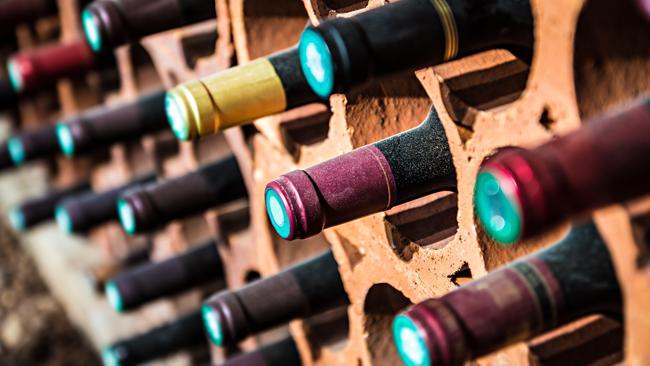Not all wine collectors find joy in organising their cellar
Oenophiles have options for organising their wines but some still prefer the joy of discovering a forgotten gem.

A wine collector friend received a call from his babysitter. She confessed she’d taken a bottle of wine from his cellar while he was out of town. The bottle turned out to be a 1982 Chateau Ducru-Beaucaillou, a second-growth bordeaux worth about $700 today.
If the babysitter hadn’t confessed to the theft, my friend says, he wouldn’t have noticed the bottle was missing. He has no formal means of tracking the 1000 or so wines in his cellar.
Many oenophiles I know — myself included — don’t have a system to keep track of the wines in our cellars. We buy bottles and put them away. I’ve definitely lost track of wines thanks to this methodless method through the years, though my losses have been to time and not babysitters, and my wines aren’t of the same calibre as those belonging to my New Jersey collector friend.
I’ve found whites deep in my racks that were a bit past their prime and reds squirrelled away in a EuroCave wine cooler that were almost completely over the hill.
Many collectors employ cellar inventory systems to avoid this kind of problem. These can be as simple as sheets of paper with the bottles purchased or consumed noted by hand, or as sophisticated as the use of wine cellar software system such as CellarTracker.
CellarTracker lets users keep detailed records of their wines, including tasting notes and date of purchase. That information can be shared with fellow users. Seattle-based founder Eric LeVine created the system in 2003 as a hobby to keep track of his own collection. “It took off from there,” he says.
When collectors begin tracking their bottles with his system they often find wines that are “borderline maturity” — almost over the hill. The system also has been a sore spot with some collectors’ spouses. “I’ve had three or four who, if they meet me, are displeased,” LeVine says.
With the cellar tracking system they no longer have free choice among the wines but must choose from a “ready to drink” section.
Another collector friend has his own system, including a “ready to drink” section plus an “almost ready to drink” box and then boxes of wines chosen specifically for his girlfriend as well as boxes of Italian wine and old Spanish wine. Nothing in his cellar is actually labelled as such, mind you; he keeps the categories in his head and knows the contents of the boxes on sight — or so he claims. In fact, he judges that he is at least 90 per cent certain of the 800 or so bottles he had in his cellar at the moment. I was sceptical.
And so, on the principle that it’s always easier to organise another person’s life than your own, I offered to help this friend sort through his collection and establish some semblance of order. To my surprise, he accepted my offer and even upped the ante to include dinner in exchange, accompanied by any wine we uncovered that he’d forgotten about and I wanted to drink.
I arrived at my friend’s house late one afternoon and we descended the steps to his cellar, really a large part of the basement of his house, a temperate 15C or so.
We immediately discovered that one of the basement lights was out. “I can’t get a repairman to fix it,” my friend complained, pulling a torch out of his pocket so we could see the bottles more clearly.
The dim light revealed a semi-chaotic arrangement of wines piled high in open wooden cases and milk crates surrounding a large wire rack that held a couple hundred more bottles. A bordeaux box held some nice second and third-growth wines and even a couple half bottles of 2006 Chateau Mouton Rothschild. “A splurge,” my friend said. Digging deeper in the bordeaux box, I uncovered several old bottles of Beringer Howell Mountain Bancroft Ranch merlot and a 2006 Alion, the Spanish red wine from Ribera del Duero made by Vega Sicilia. My friend was surprised. “I didn’t know they were there,” he said.
As we made our way to the neighbouring boxes of “better Italian wines” and “drink now Italian wines” and chablis (note: none of these were labelled as such), we found more surprise bottles: a 1999 Wolf Blass Black Label cabernet from Australia, a magnum of 1985 Clos de Tart, a grand cru burgundy and, perplexingly enough, two bottles of Finlandia vodka. The box filled with bottles of chateauneuf-du-pape turned out to be sitting on top of a box of wines from Jekel Vineyards, a California, winery. “I had no idea those wines were there!” said my friend.
I suggested we note the name of each bottle in each box on the notepad I’d brought along, but my friend resisted. He confessed he likes the surprise of not knowing exactly what he will find; it makes going down to his cellar (basement) that much more fun. “It’s like a carnival,” he said. An interesting choice of words, I commented. And I wondered what bringing the carnival under control might entail. Did he really want my help in putting his cellar in order — or did he just want to give me a tour?
We made our way to some wooden cases containing magnums of wine. My friend had never opened the cases. “All the magnums in boxes were gifts and I’ve always liked waiting to open presents,” he said. “Prolonging the surprise makes it that much more enjoyable.” I convinced him to crack the lid on one. Inside was a magnum of 2001 Tenuta Sette Ponti Crognolo, a Super Tuscan worth about $220. “I had no idea!” was becoming a familiar phrase.
We examined a few wooden boxes of cognac nearby. One had been opened and the bottle inside was nearly empty. “Holy smokes!” said my friend, holding up the bottle of Moyet Fine Champagne Cognac XO. “Who could have been drinking it?” Your girlfriend? I suggested.
After we finished our tour of the cellar, leaving it just as disorganised as when we began, my friend made dinner as promised and we tried a few of the cellar surprises. Sadly, they weren’t particularly good. The 2006 Alion was tired and dull, the 1999 Beringer Howell Mountain Bancroft Ranch merlot, all tannin and dried-out fruit. I wondered what they might have tasted like had they not languished so long in a box. My friend shrugged and went back down to the cellar. He brought up a bottle of 1990 Chateau La Conseillante from the top of the bordeaux box. “I’ve had this recently and it’s good,” he declared. (He was right.)
He also announced he’d decided to put off organising his cellar, at least for now — though he did want to solve the mystery of the cognac.
On the subject of wine theft, I went back to the victim of the babysitter. Why had she taken the bottle in the first place? “She needed a wine for Thanksgiving,” he said.
When my friend told her the cost, she said she couldn’t afford to replace it and worked off her debt in babysitting hours. It was apparently a crime worth the time.
According to my friend, the babysitter declared the wine “really good”.
The Wall Street Journal



To join the conversation, please log in. Don't have an account? Register
Join the conversation, you are commenting as Logout